This article mainly introduces the installation and use of Pycharm, which has certain reference value. Now I share it with everyone. Friends in need can refer to
Python language, 2015 programming language rankings Python ranks 6th on the list, surpassing JavaScript and PHP. It has risen two places compared to 2014. I am very optimistic about the development of Python. It is now ranked 5th. I hope that programmers who learn Python will stick to it.
Okay, let’s get to the topic: Pycharm.
I think people who read this blog must already know something about Pycharm. Below I will introduce the installation process of Pycharm, the common functions of Pycharm tools, and write simple examples. (Windows)
****************************************** ********
PycharmInstallation:
1 Download
2 Install Pycharm You can modify the installation path such as D:\PyCharm 4.5.2
3 Write the installation path of Pycharm into the PATH environment variable of Windows
4 To activate Pycharm software, you can purchase the genuine version, which can be used for 30 days, and you can use the activation code
user name: EMBRACE
key:
14203-12042010
0000107Iq75C621P7X1SFnpJpKnX
6zcwYOYaGK3euO3ehd1MiTT”2!Jny8
bff9VcTSJk7sRDLqKRVz1XGKbM qw3G
Pycharm Usage:
1 Open the Pycharm development environment and create a new project: File->New Project to open 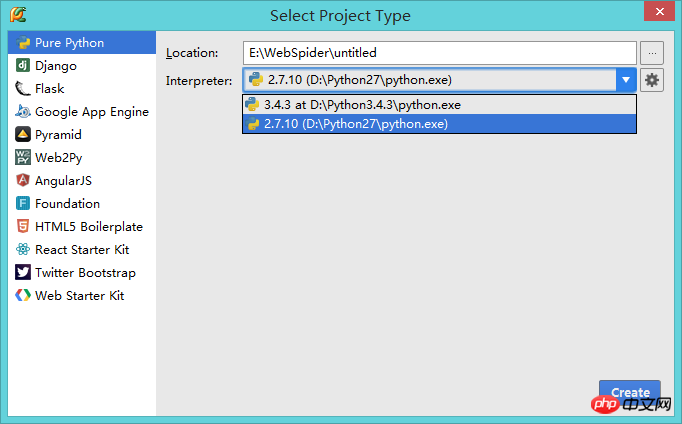
Select the project you want to build in Location Save path
Select the python.exe you have installed in Interpreter
Click Create to complete the new creation.
2 Right-click on the project name and select new->Python File 
3 Select the button as shown in the picture, select Edit Configuration from the drop-down menu, and the dialog box will pop up 
4 Click the green number in the dialogue ->Python 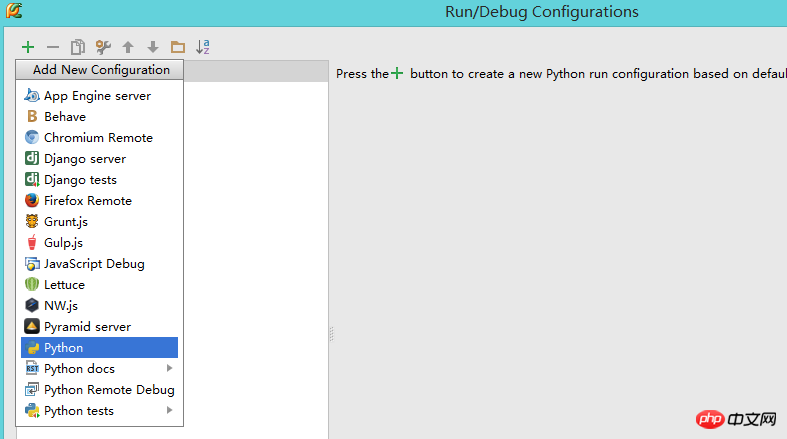
5 Name is the name of the project you built, Script is the python file you want to run (you can select it in the button below), and then Select the python compiler in the Python interpreter->OK 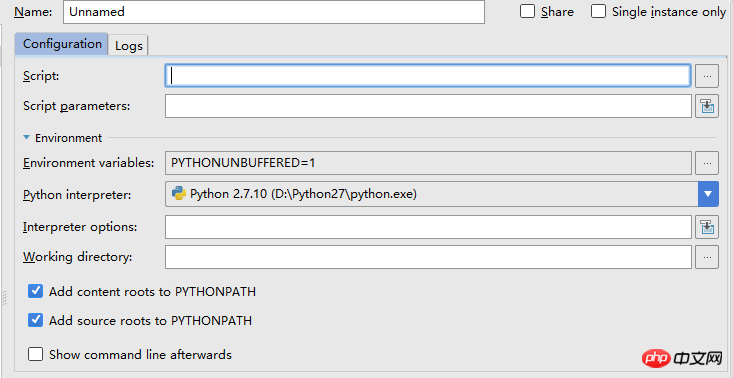
6 Select the file you want to run, right-click->Run 'file name' (green triangle button) 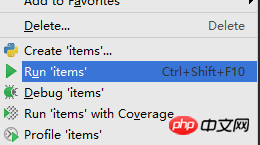
Or click the python logo in the toolbar->Select the file you want to run
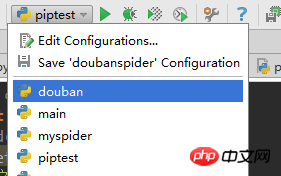 ##
##
The above is the detailed content of Pycharm installation and use. For more information, please follow other related articles on the PHP Chinese website!

Hot AI Tools

Undress AI Tool
Undress images for free

Undresser.AI Undress
AI-powered app for creating realistic nude photos

AI Clothes Remover
Online AI tool for removing clothes from photos.

Clothoff.io
AI clothes remover

Video Face Swap
Swap faces in any video effortlessly with our completely free AI face swap tool!

Hot Article

Hot Tools

Notepad++7.3.1
Easy-to-use and free code editor

SublimeText3 Chinese version
Chinese version, very easy to use

Zend Studio 13.0.1
Powerful PHP integrated development environment

Dreamweaver CS6
Visual web development tools

SublimeText3 Mac version
God-level code editing software (SublimeText3)
 How to install pandas module in pycharm
Apr 25, 2024 am 10:03 AM
How to install pandas module in pycharm
Apr 25, 2024 am 10:03 AM
How to install the Pandas module using PyCharm: Open PyCharm, create a new project, and configure the Python interpreter. Enter the command pip install pandas in the terminal to install Pandas. Verify installation: Import pandas in PyCharm's Python script. If there are no errors, the installation is successful.
 How to change python to Chinese
May 05, 2024 pm 07:48 PM
How to change python to Chinese
May 05, 2024 pm 07:48 PM
Method to modify the Python interface to Chinese: Set the Python language environment variable: set PYTHONIOENCODING=UTF-8 Modify the IDE settings: PyCharm: Settings>Appearance and Behavior>Appearance>Language (Chinese); Visual Studio Code: File>Preferences>Search "locale" > Enter "zh-CN" to modify the system locale: Windows: Control Panel > Region > Format (Chinese (China)); macOS: Language and Region > Preferred Language (Chinese (Simplified) drag to the top of the list)
 How to bring up the pycharm menu bar
Apr 25, 2024 am 10:48 AM
How to bring up the pycharm menu bar
Apr 25, 2024 am 10:48 AM
The menu bar in PyCharm provides quick access to various functions and options. To restore the menu bar: Click the View menu. Select the "Toolbar" option. Check the "Menu Bar" checkbox. Click OK. The menu bar contains the following menus: File, Edit, View, Navigate, Refactor, Run, Debug, Tools, VCS, Window, and Help.
 What to do if pycharm closes the project and gets stuck
Apr 25, 2024 am 09:42 AM
What to do if pycharm closes the project and gets stuck
Apr 25, 2024 am 09:42 AM
Solution to PyCharm getting stuck when closing the project: 1. Wait for a while; 2. Force close PyCharm; 3. Check locked files; 4. Uninstall and reinstall PyCharm; 5. Clear PyCharm cache; 6. Enable remote development; 7 . Contact PyCharm support.
 BTCC tutorial: How to bind and use MetaMask wallet on BTCC exchange?
Apr 26, 2024 am 09:40 AM
BTCC tutorial: How to bind and use MetaMask wallet on BTCC exchange?
Apr 26, 2024 am 09:40 AM
MetaMask (also called Little Fox Wallet in Chinese) is a free and well-received encryption wallet software. Currently, BTCC supports binding to the MetaMask wallet. After binding, you can use the MetaMask wallet to quickly log in, store value, buy coins, etc., and you can also get 20 USDT trial bonus for the first time binding. In the BTCCMetaMask wallet tutorial, we will introduce in detail how to register and use MetaMask, and how to bind and use the Little Fox wallet in BTCC. What is MetaMask wallet? With over 30 million users, MetaMask Little Fox Wallet is one of the most popular cryptocurrency wallets today. It is free to use and can be installed on the network as an extension
 How to adjust pycharm running configuration
Apr 25, 2024 am 09:48 AM
How to adjust pycharm running configuration
Apr 25, 2024 am 09:48 AM
Configure a run configuration in PyCharm: Create a run configuration: In the "Run/Debug Configurations" dialog box, select the "Python" template. Specify script and parameters: Specify the script path and command line parameters to be run. Set the running environment: select the Python interpreter and modify the environment variables. Debug Settings: Enable/disable debugging features and specify the debugger port. Deployment options: Set remote deployment options, such as deploying scripts to the server. Name and save the configuration: Enter a name for the configuration and save it.
 How to run code unsuccessfully with pycharm
Apr 25, 2024 am 10:36 AM
How to run code unsuccessfully with pycharm
Apr 25, 2024 am 10:36 AM
Reasons for code running failure in PyCharm include: syntax errors, import errors, path errors, version incompatibility, improper configuration of environment variables, firewall restrictions, hardware problems, etc. The solutions are: check syntax, ensure correct import of modules, check file paths, ensure version compatibility, verify environment variables, troubleshoot firewall restrictions, check hardware failures, check error messages, and seek help from the community.
 How to open the programming interface in python
May 05, 2024 pm 08:06 PM
How to open the programming interface in python
May 05, 2024 pm 08:06 PM
To open the Python programming interface, you can use the Python interpreter, IDLE, or a third-party IDE. Once opened, you can create the file, write code, run the code, and view the output.






